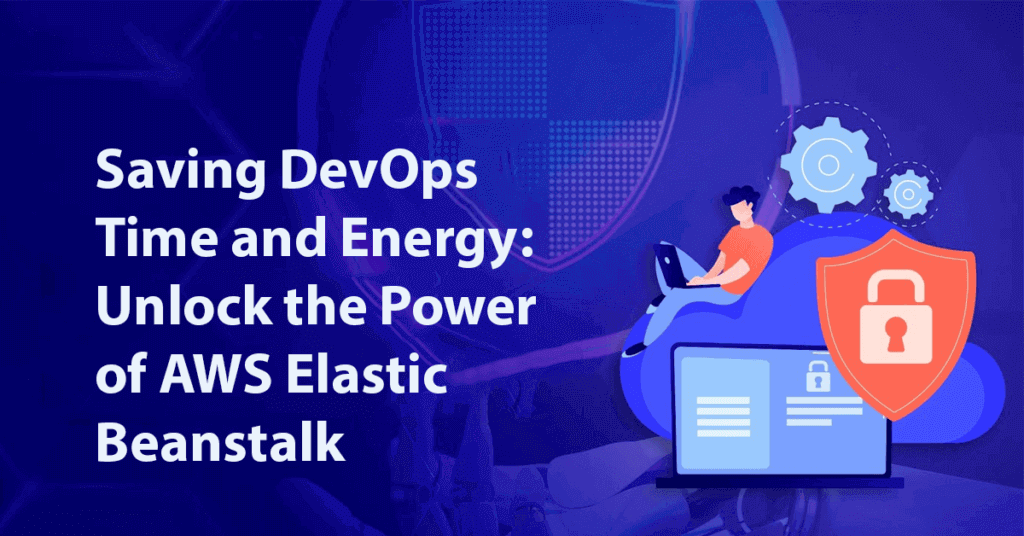Saving DevOps Time and Energy: Unlock the Power of AWS Elastic Beanstalk

As technology continues to advance, it is more important than ever for businesses to stay ahead of the game and make sure their operations are as efficient as possible. DevOps teams are no exception, constantly looking for ways to save time and energy while still achieving their goals. In this article, we will discuss how AWS Elastic Beanstalk can be a powerful tool in the DevOps process, enabling teams to save time and energy while maintaining quality standards.
AWS Elastic Beanstalk
AWS Elastic Beanstalk is a cloud computing solution that makes it easier for developers to deploy and manage applications in the AWS environment without having to worry about provisioning, scaling, and monitoring underlying infrastructure. With Elastic Beanstalk, developers can simply upload their code and let the service handle everything else. This not only saves time and energy but also reduces the risk of human errors.
Elastic Beanstalk provides an easy-to-use interface that allows developers to select their preferred programming language, web server, application platform, and database engine. The service automatically provisions resources based on user-defined configurations such as instance type, auto-scaling policies, load balancing configuration, security settings, and more. Elastic Beanstalk also integrates with other AWS services such as Amazon RDS (Relational Database Service), Amazon S3 (Simple Storage Service), Amazon CloudFront (Content Delivery Network), and others.
In addition to simplifying the deployment process, Elastic Beanstalk provides monitoring capabilities that allow developers to visualize application performance metrics such as CPU usage, memory usage, network traffic, and more. Developers can set alarms on these metrics to receive notifications when certain thresholds are exceeded. This helps them identify issues before they become critical problems thereby reducing downtime and improving overall application availability.
Also Read: Why It’s Significant for Every Developer to Be Familiar with DevOps Best Practices?
Benefits: Time and Energy Savings
AWS Elastic Beanstalk is an excellent platform for simplifying application deployment and management. It allows developers to focus more on coding, testing, and deploying their applications without worrying about the underlying infrastructure. By leveraging AWS Elastic Beanstalk, DevOps personnel can benefit from significant time savings by reducing the complexity of their daily tasks.
Another key advantage of AWS Elastic Beanstalk is that it provides auto-scaling capabilities that automatically adjust application resources based on traffic volume. This means that DevOps teams don’t have to manually monitor resource utilization and make adjustments manually, saving them both time and energy.
Moreover, AWS Elastic Beanstalk offers a range of pre-configured software stacks which can be used as a starting point for any application environment. This feature eliminates the need to configure servers and services from scratch, thus reducing setup times and making life easier for DevOps personnel who are tasked with creating new environments regularly. Ultimately, using AWS Elastic Beanstalk empowers DevOps teams to focus on higher-level business objectives instead of tedious maintenance tasks.
Elastic Beanstalk Components
Elastic Beanstalk is a fully managed service provided by AWS that enables developers to deploy, monitor, and scale their applications without worrying about the underlying infrastructure. It provides an easy-to-use interface for deploying various types of web applications using popular programming languages such as Java, .NET, PHP, Node.js, Python, Ruby and more.
The Elastic Beanstalk components consist of the application versioning system which allows you to upload your application code and configurations. The environment tier defines the resources provisioned by Elastic Beanstalk to host your application. You can choose from several pre-configured environment tiers such as Web server or Worker tier depending on your application requirements.
In addition to these main components, Elastic Beanstalk also offers features such as automatic scaling based on demand, integration with other AWS services like RDS and S3 for data storage needs and tight security through IAM roles. Leveraging these components will allow DevOps teams to focus on building great applications while saving time and energy that would otherwise be spent managing infrastructure manually.
Also Read: Best DevOps Tools & Solutions 2022: Compare DevOps Software
Cost Considerations
When considering the cost of using AWS Elastic Beanstalk for your DevOps infrastructure, there are several factors to keep in mind. First and foremost, the cost will depend on the size and complexity of your application. Larger applications with more components will require more resources and therefore cost more to run on Elastic Beanstalk.
Another consideration is the type of instances you choose to use. Elastic Beanstalk offers a range of instance types that vary in price, from small t2.micro instances to large m5.24 x large instances. Choosing the right instance type for your application can help optimise costs while still ensuring optimal performance.
Finally, it’s important to consider any additional services or add-ons you may need for your DevOps infrastructure, such as load balancers or databases. These services will incur additional costs on top of the base pricing for Elastic Beanstalk itself.
Overall, while AWS Elastic Beanstalk can offer significant time and energy savings for DevOps teams, it’s important to carefully consider all costs associated with using this service before making a decision. By taking into account factors such as application size, instance type, and additional services needed, you can ensure that you’re getting the most value out of this powerful tool without breaking the bank.
Conclusion
In conclusion, AWS Elastic Beanstalk is an excellent solution for DevOps teams looking to save time and energy. By automating infrastructure management tasks and simplifying the deployment process, Elastic Beanstalk allows developers to focus on writing code instead of worrying about server configurations. This can lead to a faster release cycle and ultimately, a better end product.
Additionally, Elastic Beanstalk provides scalability features that allow for easy expansion when necessary. With automatic scaling rules based on metrics such as CPU utilisation or network traffic, developers can ensure their applications are running smoothly without constantly monitoring performance. This results in more efficient use of resources and cost savings.
Overall, adopting AWS Elastic Beanstalk can significantly improve the productivity of DevOps teams by streamlining the deployment process and providing scalable infrastructure management. Its ease-of-use and powerful features make it an attractive option for organisations looking to optimise their development processes while reducing costs.






